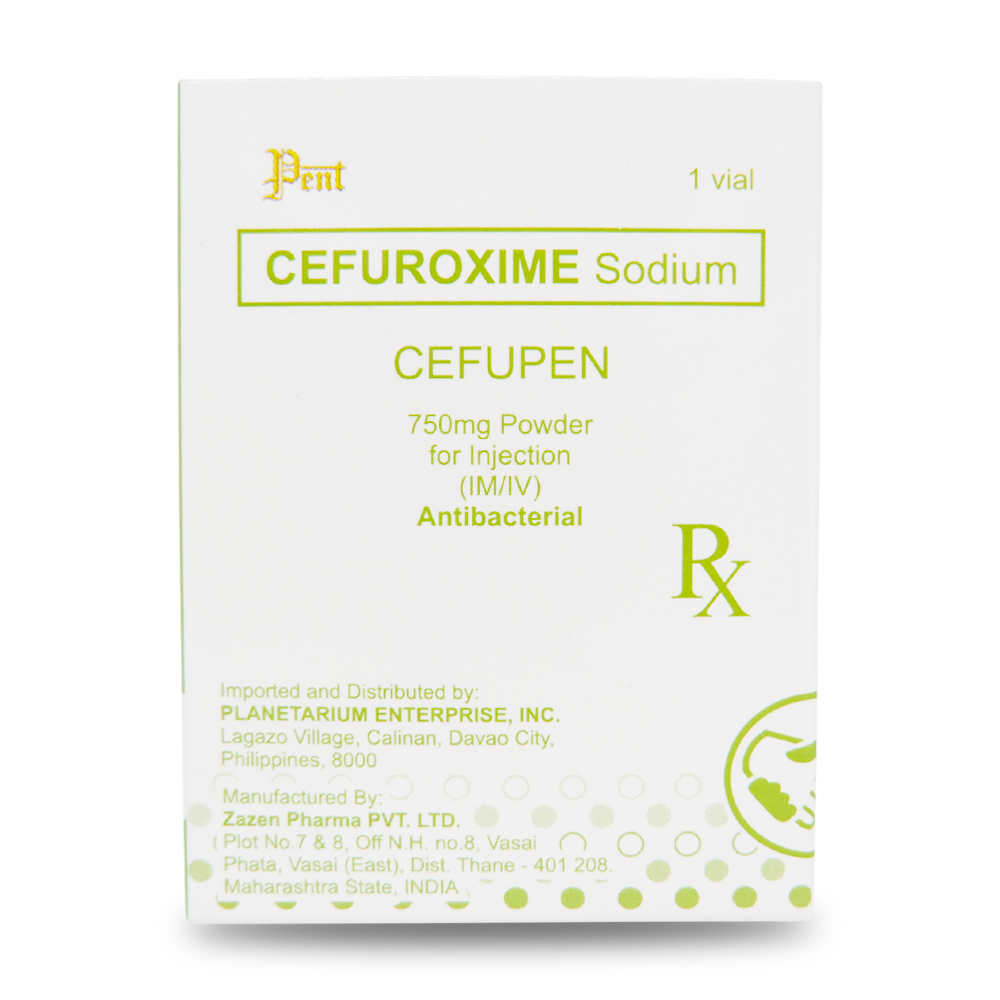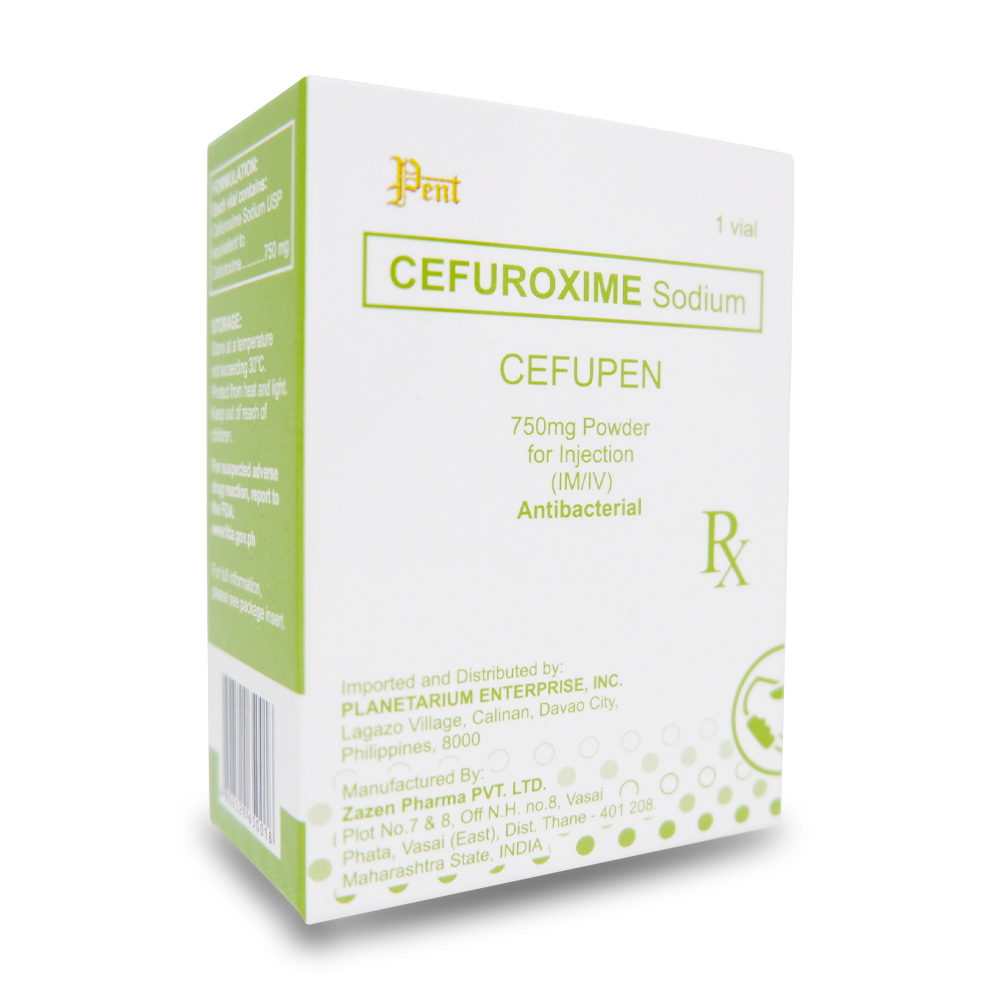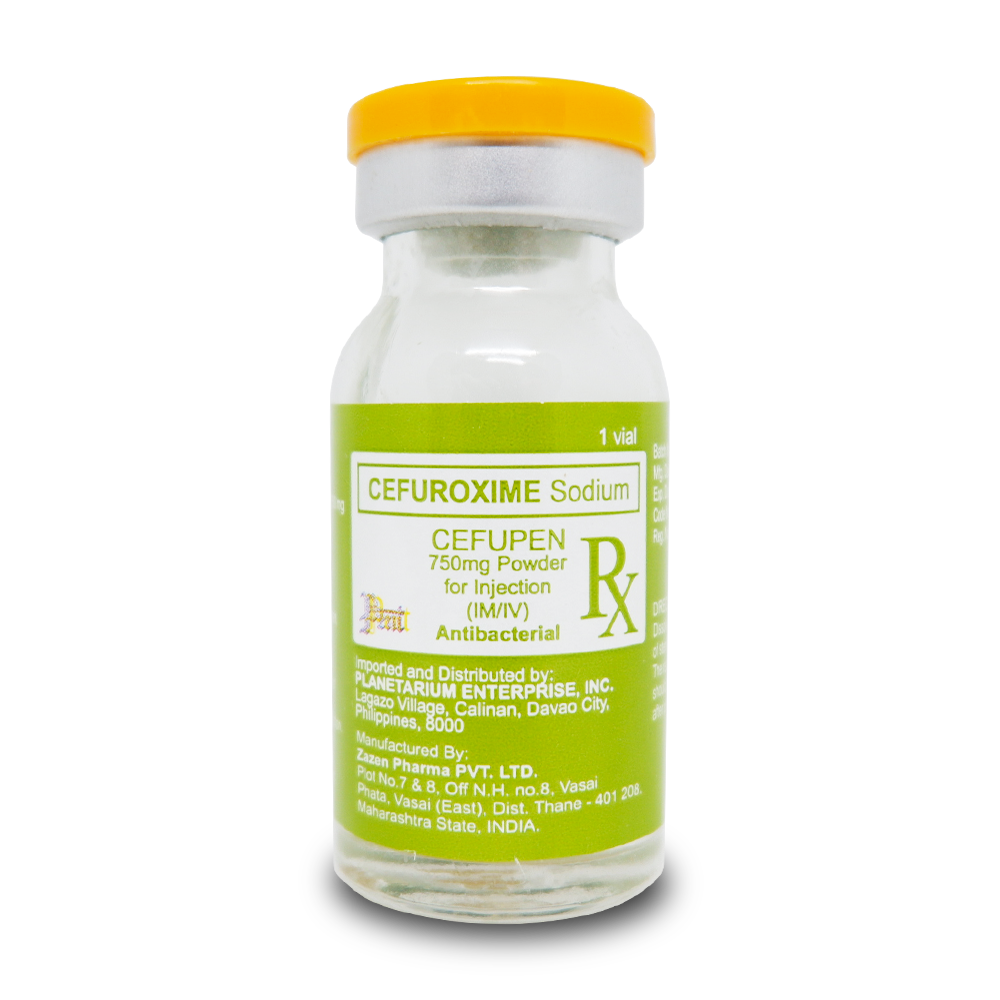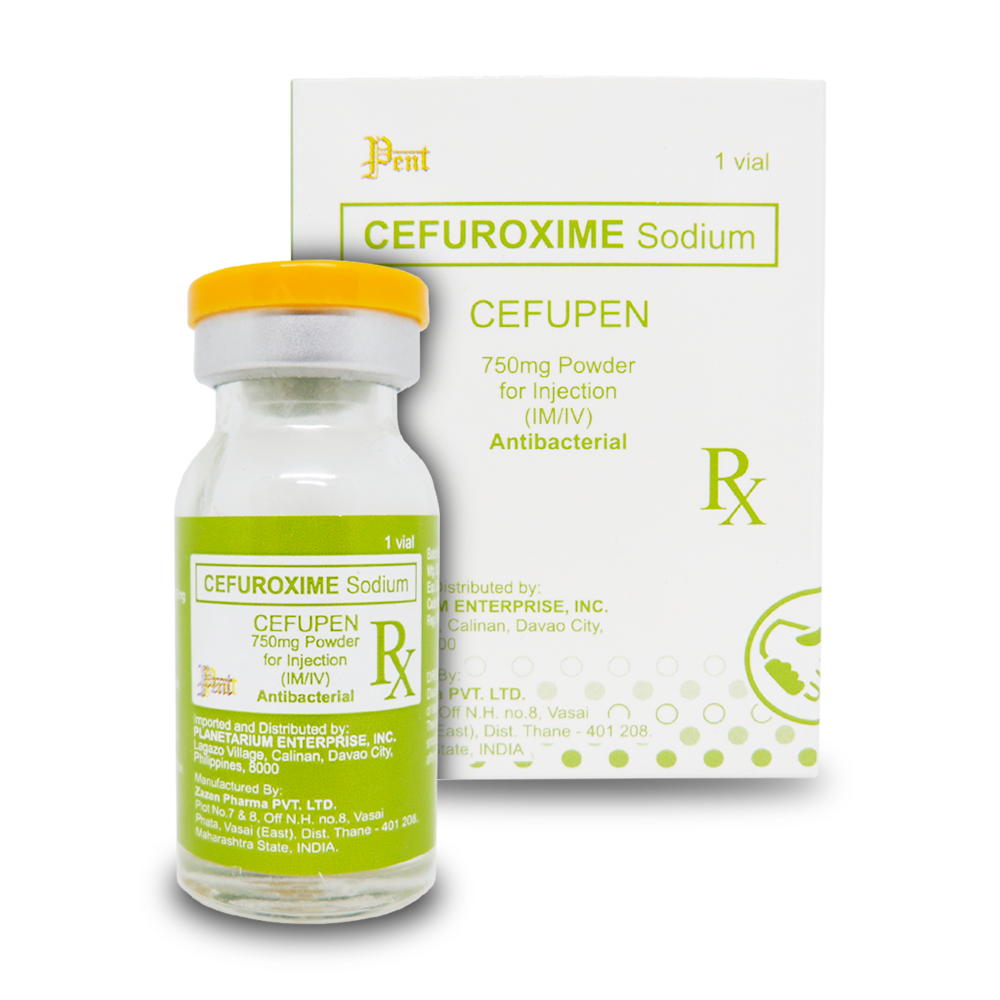



Generic Name: CEFUROXIME SODIUM
Cefupen
750mg Powder for Injection (IM/IV)
ANTIBACTERIAL
Formulation:
Each vial contains:
Cefuroxime Sodium equivalent to Cefuroxime 750 mg
Therapeutic Indications:
Antibiotic prophylaxis of postoperative endophthalmitis after cataract surgery. Consideration should be given to official guidance on the appropriate use of antibacterial agents, including guidance on the antibiotic prophylaxis on eye surgery.
Posology and Method of Administration:
Intracameral use. One vial for single-use only.
Posology
Adults:
The recommended dose is 0.1 ml of reconstituted solution, DO NOT INJECT MORE THAN THE RECOMMENDED DOSE.
Paediatric Population:
The optimal dose and the safety of CEFUPEN have not been established in the paediatric population.
Elderly:
No dose adjustment is necessary.
Patients with Hepatic and Renal Impairment:
Considering the low dose and the expected negligible systemic exposure to cefuroxime using CEFUPEN, no dose adjustment is necessary.
Method of Administration:
CEFUPEN must be administered after reconstitution by intraocular injection in the anterior chamber of the eye (intracameral use), by an ophthalmic surgeon, in the recommended aseptic conditions of cataract surgery.
After reconstitution, CEFUPEN should be inspected visually for particulate matter and discoloration prior to administration .
Slowly inject 0.1 ml of the reconstituted solution into the anterior chamber of the eye at the end of the cataract surgery.
For instructions on reconstitution of the medicinal product before administration, see section 6.6.
Contraindication:
Hypersensitivity to cefuroxime or to the cephalosporin group of antibiotics.
Special Warnings and Precautions for Use:
Treatment with CEFUPEN is for intracameral use only.
Special care is indicated in patients who have experienced an allergic reaction to penicillins or any other beta-lactam antibiotics as cross-reactions may occur.
In patients at risk for infections with resistant strains, e.g. those with known previous infection or colonisation with MRSA (Methicillin-resistant Staphylococcus aureus), alternative prophylactic antibiotic should be considered.
In the absence of data for special patient groups (patients with severe risk of infection, patients with complicated cataracts, patients having combined opera tions with cataract surgery, patients with severe thyroid disease, patients with less 2000 corneal endothelial cells), CEFUPEN should only be used after careful risk/benefit assessment.
The use of cefuroxime should not be regarded as an isolated measure but other circumstances are also of importance like prophylactic antiseptic treatment.
Corneal endothelial toxicity has not been reported at the recommended concen tration of cefuroxime; nevertheless, this risk cannot be excluded and in the post surgical surveillance, physicians should have in mind this potential risk.
Interaction with Other Medicinal Products and Other Forms of Interaction:
Since the systemic exposure is expected to be negligible, systemic interactions are unlikely.
No incompatibility with most commonly used products in cataract surgery was reported in literature.
Fertility, Pregnancy and Lactation:
Fertility:
There are no data on the effects of cefuroxime sodium on fertility in humans. Reproductive studies in animals have shown no effects on fertility.
Pregnancy:
There are limited amount of data from the use of cefuroxime in pregnant woman. Animal studies do not show any harmful effects on embryonal and foetal develop ment. Cefuroxime reaches the embryo/foetus via the placenta. No effects during pregnancy are anticipated, since systemic exposure to cefuroxime using CEFUPEN is negligible. CEFUPEN can be used during pregnancy.
Breastfeeding :
Cefuroxime is expected to be excreted in human milk in very small quantities. Adverse effects at therapeutic doses are not expected after CEFUPEN use. Cefuroxime can be used during breastfeeding.
Overdose:
The reported cases of overdose are those described in the literature after incor rect dilution and non-authorised use of cefuroxime intended for systemic adminis tration.
Inadvertent high-dose (3-fold the recommended dose) intracameral cefuroxime was administered to 6 patients following an incorrect dilution due to homemade cefuroxime dilution protocol. These injections did not cause any detectable adverse effect in any patient even on ocular tissues.
Toxicity data were available following intracameral injection, during cataract surgery, of 40 to 50-fold the recommended dose of cefuroxime in 6 patients after a dilution erro r. Initial mean visual acuity was 20/200. Severe anterior segment inflammation was present, and retinal optical coherence tomography showed extensive macular oedema. Six weeks after surgery, mean visual acuity reached 20/25. Macular optical coherence tomography profile returned to normal. A 30% decrease of scotopic electroretinography was, however, observed in all patients. Administration of incorrectly diluted cefuroxime (10-100 mg per eye) to 16 patients resulted in ocular toxicity including corneal oedema resolving in weeks, transient raised intraocular pressure, loss of corneal endothelial cells and changes in the electroretinography. A number of these patients had permanent and severe vision loss.
Pharmacological Properties:
Pharmacodynamic properties
ATC classification
Pharmacotherapeutic group: Sensory Organs – Ophthalmologicals – Antiinfectives – Antibiotics
ATC code: S01AA27.
Mechanism of action
Cefuroxime inhibits bacterial cell wall synthesis following attachment to penicillin binding proteins (PBPs). This results in the interruption of cell wall (peptidoglycan) biosynthesis, which leads to bacterial cell lysis and death.
PD/ PK (pharmacodynamics/ pharmacokinetics) relationship
For cephalosporins, the most important pharmacokinetic-pharmacodynamic index correlating with in vivo efficacy has been shown to be the percentage of the dosing interval (%T) that the unbound concentration remains above the minimum inhibitory concentration (MIC) of cefuroxime for individual target species (i.e. %T>MIC).
After intracameral injection of 1 mg cefuroxime, cefuroxime levels in the aqueous humour were over MIC for several relevant species for up to 4- 5 hours after surgery.
Mechanism of Resistance:
Bacterial resistance to cefuroxime may be due to one or more of the following mechanisms:
Hydrolysis by beta-lactamases. Cefuroxime may be efficiently hydrolysed by certain of the extended-spectrum beta-lactamases (ESBLs) and by the chromo somally-encoded (AmpC) enzyme that may be induced or stably derepressed in certain aerobic gram-negative bacterial species;
Information from clinical trials:
An academic prospective randomized partially masked multicentre cataract surgery study was performed on 16,603 patients. Twenty-nine patients (24 in “without cefuroxime” groups and 5 in “intracameral cefuroxime” groups) pre sented with endophthalmitis, of whom 20 ( 17 in “without cefuroxime” groups and 3 in “intracameral cefuroxime” groups) were classified as having proven infective endophthalmitis. Among these 20 proven endophthalmitis: 10 patients are in group “placebo eye drops and without cefuroxime”, 7 patients in group “levofloxacine eye drops and without cefuroxime”, 2 patients in group “placebo eye drops and intracameral cefuroxime” and 1 patient in group “levofloxacine eye drops and intracameral cefuroxime. The administration of intracameral cefuroxime prophylactic regimen at 1 mg in 0.1 ml sodium chloride 9 mg/ml (0.9%) solution for injection was associated with a 4.92-fold decrease in the risk for total postoperative endophthalmitis.
Two prospective studies (Wedje 2005 and Lundstrom 2007) and 5 retrospective studies were supportive to the pivotal ESCRS study further substantiating the efficacy of intracameral cefuroxime in postoperative endophthalmitis.
Pharmacokinetic Properties:
The systemic exposure following intracameral injection has not been studied but is expected to be negligible.
After intracameral injection at the recommended single dose of 0.1 ml of a 10mg/m solution of cefuroxime in cataract patients, the mean intracameral level of cefuroxime was 2614 + 209 mg/I (10 patients) 30 seconds and 1027 + 43 mg/I (9 patients) 60 minutes after drug administration.
Storage Condition:
Store below 25°C.
Keep the vial in the outer carton, in order to protect from light.
Reduced affinity of penicillin-binding proteins for cefuroxime;
Outer membrane impermeability, which restricts access of cefuroxime to penicillin binding proteins in gram-negative bacteria;
Bacterial drug efflux
Methicillin-resistant staphylococci (MRS) are resistant to all currently available lactam antibiotics including cefuroxime.
For suspected adverse drug reaction, report to the FDA: www.fda.gov.ph
location_on Lagazo Village, Calinan, Davao City
local_phone (082) 299 1768
phone_android +63 917 301 4186